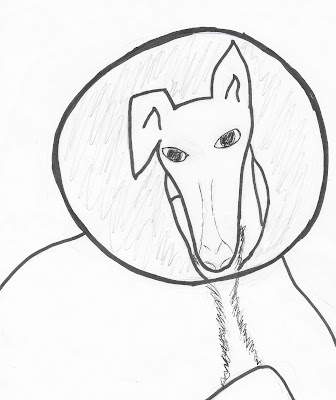stops my fun,
It hampers me
from running and playing and
being who I want to be.
The doctor was kind,
He made me better,
the problem was only
the cone on my head…errr..
It’s finally off!
And I can SEE!
No longer does poor vision
hinder me.
I run and play cone free.
One morning as I looked into the sweet face of my little black greyhound, Emma, a ray of sunshine reflected off something in her eye. I looked closer and saw a gray haze that seemed to cover her pupil. I realized that it looked like a cataract. I called my husband over so that he could inspect it. He agreed with my diagnosis. How could it be a cataract? She was only three years old, and this happened only to older animals…or so I thought.
| The Conehead |
We took her to our vet who suggested having her seen by a veterinary ophthalmologist just to see what he might recommend. As time passed, the gray area in her eye seemed to worsen so we made the appointment.
It took us almost two hours to get to the specialist’s office. He explained that the cataract was preventing almost 70% of light from getting to her retina so vision was very limited in her right eye. We decided to have the cataract removed when we could do the frequent traveling to the doctor’s office that would be required. In September, it was removed, and by that time, 90% of her vision had become impaired.
 |
| Emma and her ducky friend |
Cataract surgery is usually very successful, and so it was for Emma. She can see very well and is healing nicely. The only strange thing is that the iris in her right eye, the one operated on, is darker than in the left eye. The doctor informed us that sometimes a cataract can cause that change.
Emma’s cataract is known as a juvenile cataract. This type can happen to dogs up to 4 years of age. Sometimes puppies are born with cataracts or can get them before they reach 8 months old. These are called congenital cataracts. Finally, the ones that occur to mature dogs are called late onset or adult cataracts. Most are hereditary. However, sometimes they can appear due to trauma to the eye, other eye diseases, or diseases such as diabetes.
 |
| Looking cute |
According to Dr. Karen Becker of healthypets.mercola.com, a cataract is a clouding of the eye. “The lens is inside a clear capsule, and the cataract clouds up the inside of the capsule.” It is not a film over the eye. All cataracts do not cause blindness. Sometimes the fogging of the cataract is so minor that it does not hamper vision at all. That wasn’t the case for Emma. It was on the mature side and grew quickly from May, when I first observed it, until September when she had her surgery.
| Miserable |
Sometimes, cataracts will develop over a number of years, and the dog will be able to see until it clouds the entire lens. Cataracts are more common in pure bred dogs, and some breeds are more susceptible than others. If your ophthalmic veterinarian suggests surgery, it is better to do the surgery when the cataract is still small.
After the procedure, Emma was fitted with the cone of shame. Yep, that’s what they call it. Because greyhounds have such thin necks, her cone did not fit properly, and we had to attach it to her tag color. It looked very uncomfortable, and Emma seconded that impression by whimpering throughout the first night. After that, she got used to it, but still wasn’t a happy camper.
At first, she sullenly plodded around the house making sure everyone knew how miserable she felt. She was not allowed to run in the backyard so I had to walk her whenever she went out. She didn’t like that either. However, she was a champ at taking her eye drops and, on the whole, was a very good patient.
| Waiting to see the doctor |
After getting used to her cone, she became more animated and started running around the house. Unfortunately, she bumped into almost everything with her cone. She couldn’t seem to negotiate spaces very well. She bumped into Kiowa a lot (maybe she planned it that way) and the furniture. She also bumped into any humans in her way, but soon she began to awaken from her funk. She seemed happy again.
| The doctor examines Emma |
She had her cone on for almost 3 weeks. We also took 3 check-up trips to the doctor, and she has one more in a month. Her cone is finally off, and everything looks great in her eye. The doctor said that her vision seems clear again. I can tell by how alert she is when we are walking. When she had her cataract, I could see a change in her behavior in that she was tenuous around objects in the backyard. Now, she seems to be taking in everything and is back to her spunky self.
I am so glad that we decided on the surgery especially due to her youth. It was expensive, but her quality of life is improved and back to where it should be. However, she will always remain my conehead.
Resources:
Healthy Pets with Dr. Karen Becker, “Cataracts: 75% of Dogs Develop Blindness within 1 Year of This Diagnosis”, January 10, 2012, healthypets.mercola.com
DogHeirs Team, “Cataracts”, April 15, 2010, dogheirs.com
The Daily Vet, “Juvenile Cataracts” by Dr Lisa Radosta, August 29, 2012, petmd.com

